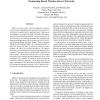Free Online Productivity Tools
i2Speak
i2Symbol
i2OCR
iTex2Img
iWeb2Print
iWeb2Shot
i2Type
iPdf2Split
iPdf2Merge
i2Bopomofo
i2Arabic
i2Style
i2Image
i2PDF
iLatex2Rtf
Sci2ools
IPPS
2006
IEEE
2006
IEEE
Preserving source location privacy in monitoring-based wireless sensor networks
While a wireless sensor network is deployed to monitor certain events and pinpoint their locations, the location information is intended only for legitimate users. However, an eavesdropper can monitor the traffic and deduce the approximate location of monitored objects in certain situations. We first describe a successful attack against the flooding-based phantom routing, proposed in the seminal work by Celal Ozturk, Yanyong Zhang, and Wade Trappe. Then, we propose GROW(GreedyRandomWalk), atwo-wayrandomwalk, i.e., from both source and sink, to reduce the chance an eavesdropper can collect the location information. We improve the delivery rate by using local broadcasting and greedy forwarding. Privacy protection is verified under a backtracking attack model. The message delivery time is a little longer than that of the broadcasting-based approach, but it is still acceptable if we consider the enhanced privacy preserving capability of this new approach. At the same time, the energy ...
Distributed And Parallel Computing | IPPS 2006 | Location Information | Sensor Network | Wireless Sensor Network |
| Added | 12 Jun 2010 |
| Updated | 12 Jun 2010 |
| Type | Conference |
| Year | 2006 |
| Where | IPPS |
| Authors | Yong Xi, Loren Schwiebert, Weisong Shi |
Comments (0)

